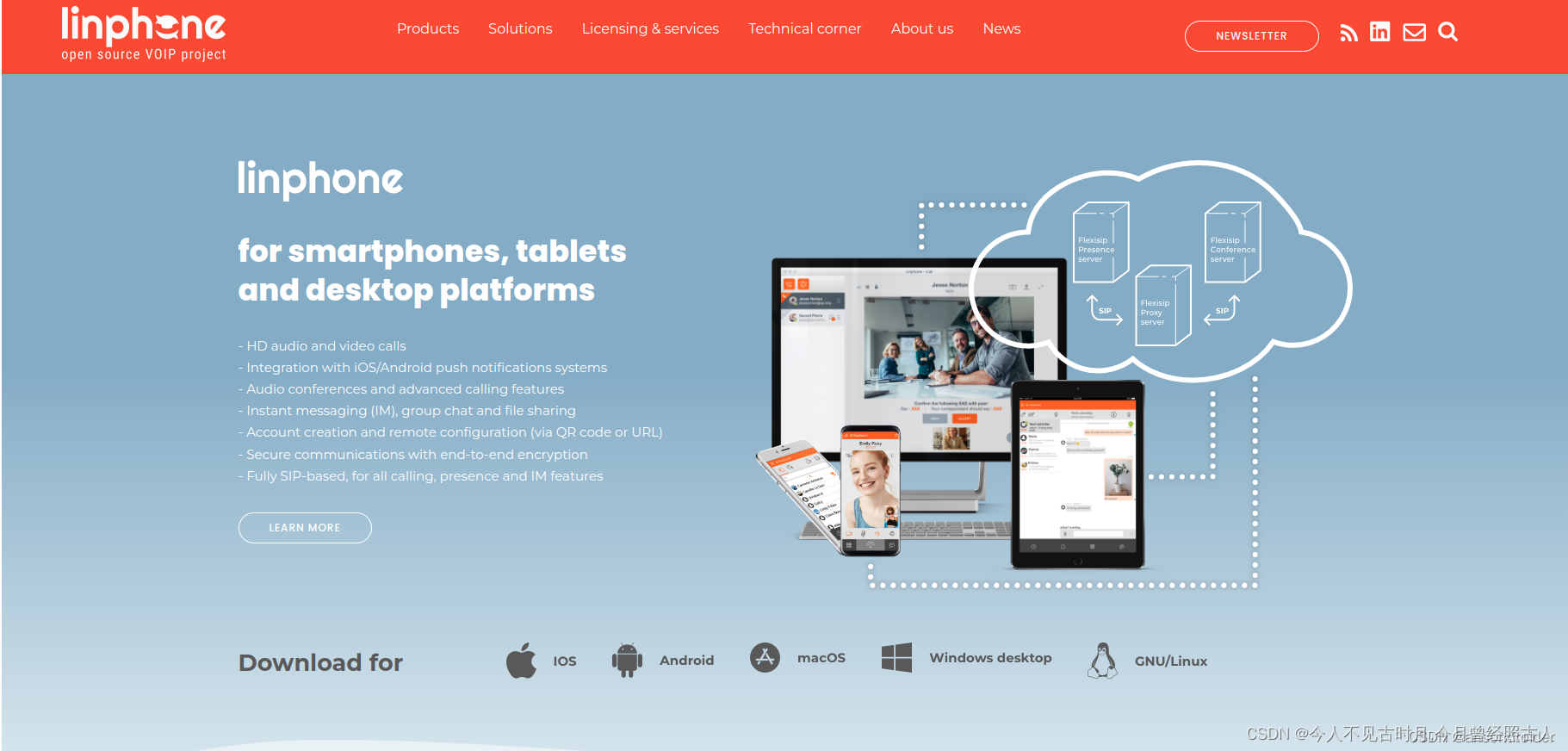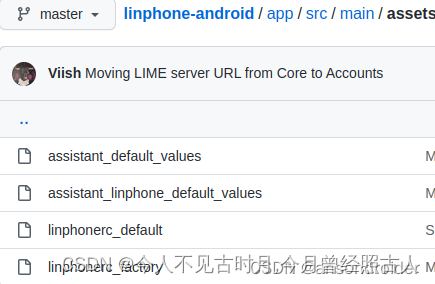平台
RK3288 + Linphone 5.1.0 + Android Studio概述
简单来说, 有了解过互联网电话服务或IM(即时消息)功能的.一般都会接触到VOIP和SIP, 实现即时通讯, 发文本消息也好话音通话也好, 甚至于视频通话.
关于SIP(Session Initiation Protocol,会话初始协议)
VoIP是一个广义术语,可用于描述任何互联网电话服务,从低成本的住宅服务到企业统一通信工具的复杂实现。VoIP是一个可以用来描述任何基于Internet的电话服务的术语,而SIP是一种用于大多数类型VoIP部署的通信协议。
在早期开发android的SIP 客户端的时候, 常常可以看到sipdroid的身影, 在前面的文章中已经有提及过并使用测试过, 只是这个项目目前来看, 只能用于做做DEMO, 简单的测试一些功能, 如注册, 登陆, 发文本消息之类的, 项目的推进/更新也不积极,
|-- 尝试过另外两个项目:
|–csipsimple: 不好用/不会用
|–abto_sip: 可测试用, 某些平台崩溃,官方付费
最终采用了Linphone
自 2001 年作为第一个在 Linux 上使用 SIP 的开源应用程序推出以来,Linphone 已经变得非常流行,尤其是在开源社区中。 我们的工程团队一直致力于 Linphone 项目,以支持最流行平台的最新版本,并提供高级语音/视频和即时消息功能。

linphone-android客户端源码
linphone-SDK
使用Linphone-sdk打造一个SIP客户端
Gradle 版本

从linphone-SDK下载对应SDK并添加依赖
当前使用的版本是 linphone-sdk-android-5.1.0-beta.aar
build.gradle
dependencies {
implementation files('libs/linphone-sdk-android-5.1.0-beta.aar')
}SipPhone.java : 初始化
import org.linphone.core.Account;
import org.linphone.core.AuthInfo;
import org.linphone.core.Call;
import org.linphone.core.CallParams;
import org.linphone.core.Config;
import org.linphone.core.Core;
import org.linphone.core.CoreListener;
import org.linphone.core.CoreListenerStub;
import org.linphone.core.Factory;
public class SipPhone extends IPhone {
Factory factory;
Core core;
AuthInfo user;
AccountParams accountParams;
Call currentCall;
//初始化Factory, 在APP启动时调用.
public static void loadSipLibs(){
Factory.instance();
}
void initSip(Activity activity){
Logger.i(TAG, "initSip");
factory = Factory.instance();
core = factory.createCore(null, null, activity);
core.addListener(coreListener);
//配置视频通话
core.enableVideoCapture(true);
core.enableVideoDisplay(true);
core.getVideoActivationPolicy().setAutomaticallyAccept(true);
//音频部分, 这里增加了一个遍历, 用于设置指定的音频格式.
//h264, no VP8 fixed outgoing call no video.
PayloadType[] payloads = core.getVideoPayloadTypes();
for(int i = 0; i < payloads.length; i ++){
//Payload:null, VP8/90000/0, A VP8 video encoder using libvpx library., VP8
//Payload:profile-level-id=42801F, H264/90000/0, A H264 encoder based on MediaCodec API., H264
PayloadType pt = payloads[i];
//判断是否指定的音频格式.
boolean goodPayload = PREFER_PAYLOAD.equals(pt.getMimeType());
pt.enable(goodPayload);
}
//https://github.com/BelledonneCommunications/linphone-android/issues/1153
//https://blog.csdn.net/AdrianAndroid/article/details/70048040
//do not working
//H264Helper.setH264Mode(H264Helper.MODE_AUTO, core);
//回声消除, 与音频增益.
//Logger.d(TAG, "initSip Cancellation=" + core.echoCancellationEnabled());
Logger.d(TAG, "initSip getMicGainDb=" + core.getMicGainDb());
Logger.d(TAG, "initSip PlaybackGainDb=" + core.getPlaybackGainDb());
//core.enableEchoCancellation(true);
Logger.d(TAG, "initSip finish Cancellation=" + core.echoCancellationEnabled());
}
}SipPhone.java : 登陆
void login(){
i("login");
String username = PreferenceUtils.getStringFromDefault(App.getApp(), App.PREF_VOIP_USER, "");
String password = PreferenceUtils.getStringFromDefault(App.getApp(), App.PREF_VOIP_PWD, "");
String domain = PreferenceUtils.getStringFromDefault(App.getApp(), App.PREF_VOIP_IP, "");
String port = PreferenceUtils.getStringFromDefault(App.getApp(), App.PREF_VOIP_PORT, App.DEF_SIP_PORT);
if(!StringTools.isNotEmpty(username, password, domain, port)){
e("login failed: username(" + username + "), password(" + password + "), domain(" + domain + "), port(" + port + ")");
return;
}
//sip:100@192.168.7.119:6060
if(!domain.contains(":")){
domain += ":" + port;
}
user = factory.createAuthInfo(username, null, password, null, null, domain, null);
accountParams = core.createAccountParams();
// A SIP account is identified by an identity address that we can construct from the username and domain
String sipAddress = "sip:" + username + "@" + domain;
Address identity = factory.createAddress(sipAddress);
i("login for address " + sipAddress);
accountParams.setIdentityAddress(identity);
// We also need to configure where the proxy server is located
Address address = factory.createAddress("sip:" + domain);
// We use the Address object to easily set the transport protocol
address.setTransport(TransportType.Udp);
accountParams.setServerAddress(address);
// And we ensure the account will start the registration process
accountParams.setRegisterEnabled(true);
// Asks the CaptureTextureView to resize to match the captured video's size ratio
//core.getConfig().setBool("video", "auto_resize_preview_to_keep_ratio", true);
// Now that our AccountParams is configured, we can create the Account object
Account account = core.createAccount(accountParams);
//account.setCustomHeader("Header1", "Header2");
// Now let's add our objects to the Core
core.addAuthInfo(user);
core.addAccount(account);
// Also set the newly added account as default
core.setDefaultAccount(account);
core.setUserAgent("User", "Agent");
// Finally we need the Core to be started for the registration to happen (it could have been started before)
core.start();
}
void logout(){
i("logout");
Account account = core.getDefaultAccount();
if(account != null) {
accountParams = account.getParams().clone();
accountParams.setRegisterEnabled(false);
account.setParams(accountParams);
}
}SipPhone.java : 通话部分
//拨打电话.
@Override
public void call(String number, boolean video) {
i("call " + number + " video(" + video + ")");
String domain = PreferenceUtils.getStringFromDefault(App.getApp(), App.PREF_VOIP_IP, "");
String port = PreferenceUtils.getStringFromDefault(App.getApp(), App.PREF_VOIP_PORT, App.DEF_SIP_PORT);
// As for everything we need to get the SIP URI of the remote and convert it to an Address
String remoteSipUri = "sip:" + toNumber + "@" + domain + ":" + port;
Address remoteAddress = factory.createAddress(remoteSipUri);
if(remoteAddress == null)return;
// If address parsing fails, we can't continue with outgoing call process
// We also need a CallParams object
// Create call params expects a Call object for incoming calls, but for outgoing we must use null safely
CallParams params = core.createCallParams(null);
// We can now configure it
// Here we ask for no encryption but we could ask for ZRTP/SRTP/DTLS
params.setMediaEncryption(MediaEncryption.None);
params.enableVideo(video);
//show preview before caling.
//core.enableVideoPreview(video);
// Finally we start the call
core.inviteAddressWithParams(remoteAddress, params);
//回声消除
// Call process can be followed in onCallStateChanged callback from core listener
}
//挂断
@Override
public void hangup() {
i("hangup");
if (core.getCallsNb() == 0) return;
// If the call state isn't paused, we can get it using core.currentCall
Call call = core.getCurrentCall() != null ? core.getCurrentCall() : core.getCalls()[0];
if(call != null) {
// Terminating a call is quite simple
call.terminate();
}
}
//接听/应答
@Override
public void answer() {
i("answer");
if(currentCall != null){
if(remoteHasVideo()) {
enableCamera();
currentCall.getParams().enableVideo(true);
}
currentCall.accept();
}
}SipPhone.java : 监听和回调
//在initSip中使用.
CoreListener coreListener = new CoreListenerStub(){
@Override
public void onCallStateChanged(Core core, Call call, Call.State state, String message) {
d("onCallStateChanged " + state);
currentCall = call;
if(state == Call.State.OutgoingProgress){
//呼出
}else if(state == Call.State.IncomingReceived){
//来电
}else if(state == Call.State.StreamsRunning){
//通话中, 有音视频流.
}else if(state == Call.State.UpdatedByRemote){
//通话变化, 有可能变成语音, 也有可能是带视频...
}else if(state == Call.State.Released){
//挂电或结束通话
}else if(state == Call.State.Error){
//出错.
}
}
@Override
public void onRegistrationStateChanged(Core core, ProxyConfig proxyConfig, RegistrationState state, String message) {
//message:
// case "io error": server offline.
//
i("onRegistrationStateChanged " + state + " with msg:" + message);
//((Button)findViewById(R.id.btLogin)).setText(state == RegistrationState.Ok ? "Logout":"Login");
if(state == RegistrationState.Ok) {
//登陆成功
}else{
//登出
}
}
};
关于视频部分:
如何设置视频显示的控件, 在通话呼起后可以调用这个函数.
public void setVideoView(View v1, View v2){
core.setNativePreviewWindowId(v1);
core.setNativeVideoWindowId(v2);
}所有的功能接口, 请以参考源码及官方为主
强烈建议下载linphone-android客户端源码并编译运行, 学习如何更好地使用SDK开发自己需要的功能
配置文件
在优化视频通话的过程中, 接触到关于初始化配置的问题. 很多资料显示, 可能通过配置方件的方式, 配置优化音频参数来优化通话效果:
Echo suppression does not work
Android音视频通话——Linphone开发笔记总结
2022-09-24-voice_communication_audio_codec.md
大致的方法是:
1.增加配置文件
assets/linphone_factory或 assets/linphonerc_factory
res/raw/linphone_factory 或 res/raw/linphonerc_factory
2.编写对应配置
[sip]
guess_hostname=1
register_only_when_network_is_up=1
auto_net_state_mon=1
auto_answer_replacing_calls=1
ping_with_options=0
use_cpim=1
zrtp_key_agreements_suites=MS_ZRTP_KEY_AGREEMENT_K255_KYB512
chat_messages_aggregation_delay=1000
chat_messages_aggregation=1
[sound]
#remove this property for any application that is not Linphone public version itself
ec_calibrator_cool_tones=1
# 打开回声消除
echocancellation=1
# MIC 增益
mic_gain_db=0.0
# 回放增益
playback_gain_db=0.0
[video]
displaytype=MSAndroidTextureDisplay
auto_resize_preview_to_keep_ratio=1
max_mosaic_size=vga3.打包到程序中运行.

以上这些方法, 仅适用于linphone-android客户端源码, 针对基于SDK开发的话, 则需要在对应的地方加入载入配置文件的代码:
//参考
//-linphone-android/app/src/main/java/org/linphone/core/CorePreferences.kt
//-linphone-android/app/src/main/java/org/linphone/LinphoneApplication.kt
//在创建Core之前载入配置文件.
Config config = factory.createConfigWithFactory(App.LINPHONE_CONFIG_DEF, App.LINPHONE_CONFIG_FAC);
core = factory.createCoreWithConfig(config, App.getApp().getActivity());参考
Ubuntu搭建简单SIP服务器并使用sipdroid测试
一文详解SIP 协议- xiaxueliang - 博客园
sipdroid
————————————————
原文链接:https://blog.csdn.net/ansondroider/article/details/127743946























 9273
9273











 被折叠的 条评论
为什么被折叠?
被折叠的 条评论
为什么被折叠?








